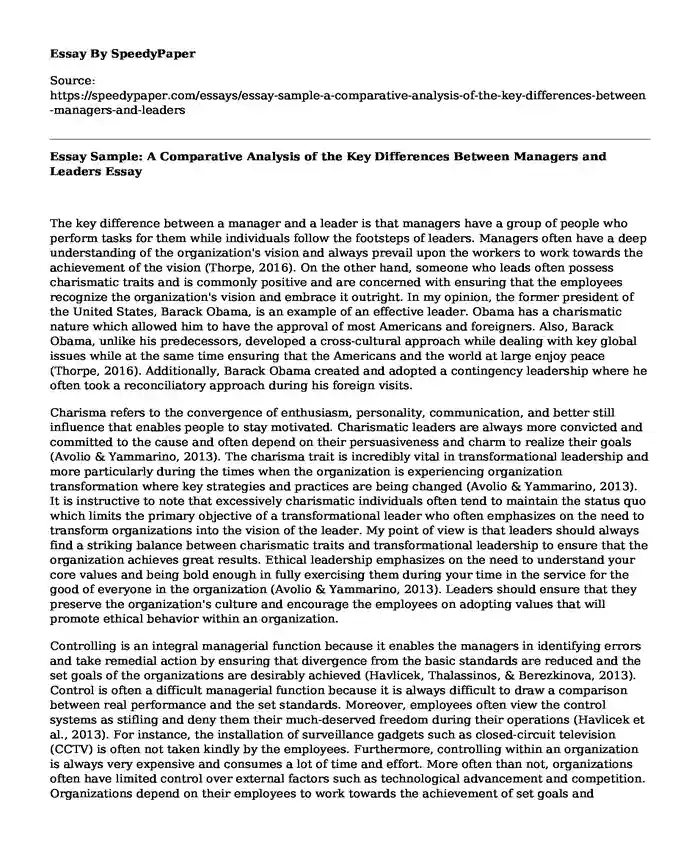
| Type of paper: | Critical thinking |
| Categories: | Management Leadership development Leadership style |
| Pages: | 3 |
| Wordcount: | 647 words |
The key difference between a manager and a leader is that managers have a group of people who perform tasks for them while individuals follow the footsteps of leaders. Managers often have a deep understanding of the organization's vision and always prevail upon the workers to work towards the achievement of the vision (Thorpe, 2016). On the other hand, someone who leads often possess charismatic traits and is commonly positive and are concerned with ensuring that the employees recognize the organization's vision and embrace it outright. In my opinion, the former president of the United States, Barack Obama, is an example of an effective leader. Obama has a charismatic nature which allowed him to have the approval of most Americans and foreigners. Also, Barack Obama, unlike his predecessors, developed a cross-cultural approach while dealing with key global issues while at the same time ensuring that the Americans and the world at large enjoy peace (Thorpe, 2016). Additionally, Barack Obama created and adopted a contingency leadership where he often took a reconciliatory approach during his foreign visits.
Charisma refers to the convergence of enthusiasm, personality, communication, and better still influence that enables people to stay motivated. Charismatic leaders are always more convicted and committed to the cause and often depend on their persuasiveness and charm to realize their goals (Avolio & Yammarino, 2013). The charisma trait is incredibly vital in transformational leadership and more particularly during the times when the organization is experiencing organization transformation where key strategies and practices are being changed (Avolio & Yammarino, 2013). It is instructive to note that excessively charismatic individuals often tend to maintain the status quo which limits the primary objective of a transformational leader who often emphasizes on the need to transform organizations into the vision of the leader. My point of view is that leaders should always find a striking balance between charismatic traits and transformational leadership to ensure that the organization achieves great results. Ethical leadership emphasizes on the need to understand your core values and being bold enough in fully exercising them during your time in the service for the good of everyone in the organization (Avolio & Yammarino, 2013). Leaders should ensure that they preserve the organization's culture and encourage the employees on adopting values that will promote ethical behavior within an organization.
Controlling is an integral managerial function because it enables the managers in identifying errors and take remedial action by ensuring that divergence from the basic standards are reduced and the set goals of the organizations are desirably achieved (Havlicek, Thalassinos, & Berezkinova, 2013). Control is often a difficult managerial function because it is always difficult to draw a comparison between real performance and the set standards. Moreover, employees often view the control systems as stifling and deny them their much-deserved freedom during their operations (Havlicek et al., 2013). For instance, the installation of surveillance gadgets such as closed-circuit television (CCTV) is often not taken kindly by the employees. Furthermore, controlling within an organization is always very expensive and consumes a lot of time and effort. More often than not, organizations often have limited control over external factors such as technological advancement and competition. Organizations depend on their employees to work towards the achievement of set goals and objectives (Havlicek et al., 2013). However, organizations often face different challenges associated with controlling where the management fails to understand the needs and the resources required by the employees to ensure that they work efficiently and effectively. Also, managers sometimes face the challenge of comparing performance and predetermined standards.
References
Avolio, B. J., & Yammarino, F. J. (Eds.). (2013). Introduction to, and overview of, transformational and charismatic leadership. In Transformational and Charismatic Leadership: The Road Ahead 10th Anniversary Edition (pp. xxvii-xxxiii). Emerald Group Publishing Limited.
Havlicek, K., Thalassinos, I. E., & Berezkinova, L. (2013). Innovation management and controlling in SMEs. European Research Studies Journal, 16(4), 57-70.
Thorpe, R. (2016). Gower handbook of leadership and management development. CRC Press.
Cite this page
Essay Sample: A Comparative Analysis of the Key Differences Between Managers and Leaders. (2023, Jan 29). Retrieved from https://speedypaper.net/essays/essay-sample-a-comparative-analysis-of-the-key-differences-between-managers-and-leaders
Request Removal
If you are the original author of this essay and no longer wish to have it published on the SpeedyPaper website, please click below to request its removal:
- Essay Sample on Witches Loaves by O'Henry
- Sustainability and Leadership, Business Essay Example
- Incidents in the Life of a Slave Girl - Book Review Essay Example
- Free Paper Sample on Implementing Telework at Children's National Medical Center
- Essay Example on Wellness in Society
- Essay Sample on Depression in the UAE
- Essay Sample on The Voucher System
Popular categories




